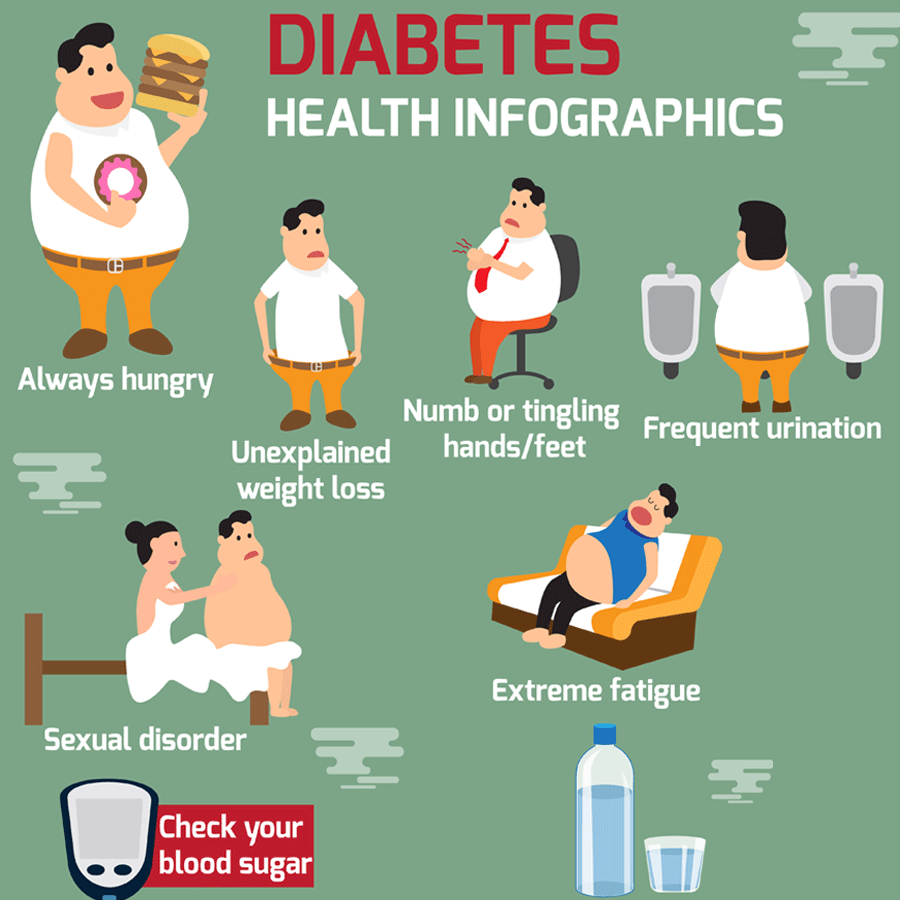Diabetes commonly refers to diabetes mellitus which is a disorder of glucose metabolism. It occurs when the body either does not produce adequate amount of insulin (a hormone that regulates blood glucose) and/or can not make effective use of the insulin it produces.
There are two main types of diabetes.
Type 1 diabetes is due to destruction of pancreatic cells that produce insulin through an autoimmune mechanism. Since the main defect lies in decreased production of insulin the primary treatment modality is by Insulin therapy.
Type 2 diabetes is the more common variety and is characterized mainly by resistance to the action of the insulin produced. Thus the treatment lies in decreasing the insulin resistance or in increasing the insulin production by the pancreas. In long standing cases, Insulin may be required as there may be failure of the pancreas.
Diabetes is an increasing problem of public health. Today, 415 million people worldwide suffer from diabetes and this figure is expected to increase to 642 million by 2040. There were 69.1 million cases of diabetes in India in 2015.
Presence of predisposing factors, such as genetic causes (family history, increased risk in some ethnic groups) and environmental conditions (unhealthy diet, obesity, lack of physical activity) predispose the person to the development of diabetes.
Healthy eating and regular exercise can prevent or delay the onset of type 2 diabetes. However some people are strongly genetically predisposed to develop diabetes. Regular measurement of blood glucose levels in individuals at high risk enables early detection of pre diabetes (which is a sign of imminent diabetes). Pharmacological or behavioural intervention at this stage can prevent the onset of diabetes.
Typical symptoms of diabetes include excessive urine excretion (polyuria), excessive thirst (polydipsia), dry mouth, persistent hunger, weight loss, blurred vision, drowsiness and easy fatigue. These symptoms may occur suddenly or progressively . In some cases, type 2 diabetes is asymptomatic and diagnosis only occurs when complications develop.
Diabetes can lead to various complications, either sudden, such as diabetic coma, or over time due to the damage caused by elevated blood glucose levels in large and small arteries. Common complications include myocardial infarction (heart attack), stroke , retinopathy (visual problem), kidney disease , neuropathy (nerve problems), and the formation of leg ulcers (diabetic foot) that can even lead to removal of limb.
Note that in most cases symptoms of complications appear only during late stages at which point recovery is difficult. These complications can be detected early only by targeted testing, which is why seeking expert consultation is mandatory without delaying for appearance of symptoms.
Diabetes is diagnosed by any one of the following criteria:
- Symptoms of diabetes and a blood glucose value greater than or equal to 200 mg / dL at random estimation
- Blood glucose greater than or equal to 126 mg / dL after fasting (not eating for at least 8 hours, usually after overnight fast).
- Blood glucose level greater than or equal to 200 mg / dL , two hours after a glucose tolerance test (made by swallowing a solution containing 75 g of anhydrous glucose).
- Glycosylated hemoglobin A1c (HbA1c) greater than or equal to 6.5%
The above tests should be repeated on another day to confirm the diagnosis of diabetes.
Definition of pre-diabetes includes any of the following criteria:
- Blood glucose value between 100 mg / dL and 125 mg / dL after overnight fast.
- Blood glucose value between 140 mg / dL and 199 mg / dL two hours after a glucose tolerance test.
- HbA1c was between 5.7 and 6.4%.
A fasting plasma glucose of 80 – 130 mg/dl and a post meal plasma glucose of less than 180 mg/dl is considered as accepted control of diabetes.
The value of glycosylated hemoglobin (HbA1c) reflects the mean blood glucose level over the last two to three months. A value of 6.5% is generally targeted. In elderly patients value of 7% can be considered. In type 1 diabetics, value of 7.5 % can be considered and value of 6.5% can be targeted if low glucose levels do not occur frequently.



